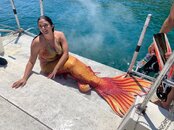SpaceX Aquanaut
Banned
Fair enough. You’re free to “move the goalposts” -to reiterate if you don’t like 1 minute stops, change that factor to 0.3 minute (20 second stop, split into a 10 second hold & 10 second travel between stops in easier practice).I don't have an issue with that calculation. And I have figured out gas/ascent calculations for myself "longhand" and built my own spredsheet for fun to more easily play with different variations. I haven't needed much spoonfeeding for about 55 years, but of course things do have a way of coming around.
But that is NOT calculated with the parameters that you have been repeatedly discussing - that is moving the goalposts. The one minute STOP after ascent of EVERY 3m/10' was what I took issue with. The resulting average ascent rate is a quater of the generally-accepted, current "safe" ascent rate.
[I am pre-editing here to be thorough and point out that I went back and you did explain that your procedure is actually a one minute NET ascent and hold cycle which would result in a 10'/minute average ascent rate. You have repeatedly referred to one-minute stops in susequent posts and I believe that variability is significantly clouding the issue here (certainly for me.)]
And that IMO does make the resulting calculations irrelevant to novice divers who would reasonably be expected to ascend at the nominal 30'/minute rate they were trained to.
I actually find your methodolgy conceptually intriguing. It does bind the ascent into an arguably more controlled situation. I do find the length of those stops unnecessarily long at the expense of other important factors - boiled down: more time at depth, less available gas for the unexpected and time at more beneficial offgassing depths.
As I pointed out, a 10 second stop guarantees a maximum of 60'/minute rate. Even if you actually ascend (between stops) at 60'/minute, with the 10 second stop, your average ascent rate is only 30'/minute. And if you ascend (between stops) at 30'/minute your average ascent rate only falls to 20'/minute - a bit safer if you are concermed that 30' is too aggressive, but with far less negative impact (IMO). In other posts you have made much the same profile suggestion.
[Reiterating: There seem to be several different intermixed profiles presented and this has been confusing (again - at least to me - sorry to the extent that my loss of context led to more critical tone.) The coceptual ascent methodology is worth thoughtful discussion.]
[Go Rams -Beat the Eagles! LAFD Strong!]
@SpaceX Aquanaut
Doing the math isn’t the issue. That is not ascent strategy that makes sense to me or several others. That’s the issue.
You did you use the term ‘min deco’ somewhere in there. May I ask where you got this particular ascent strategy?




